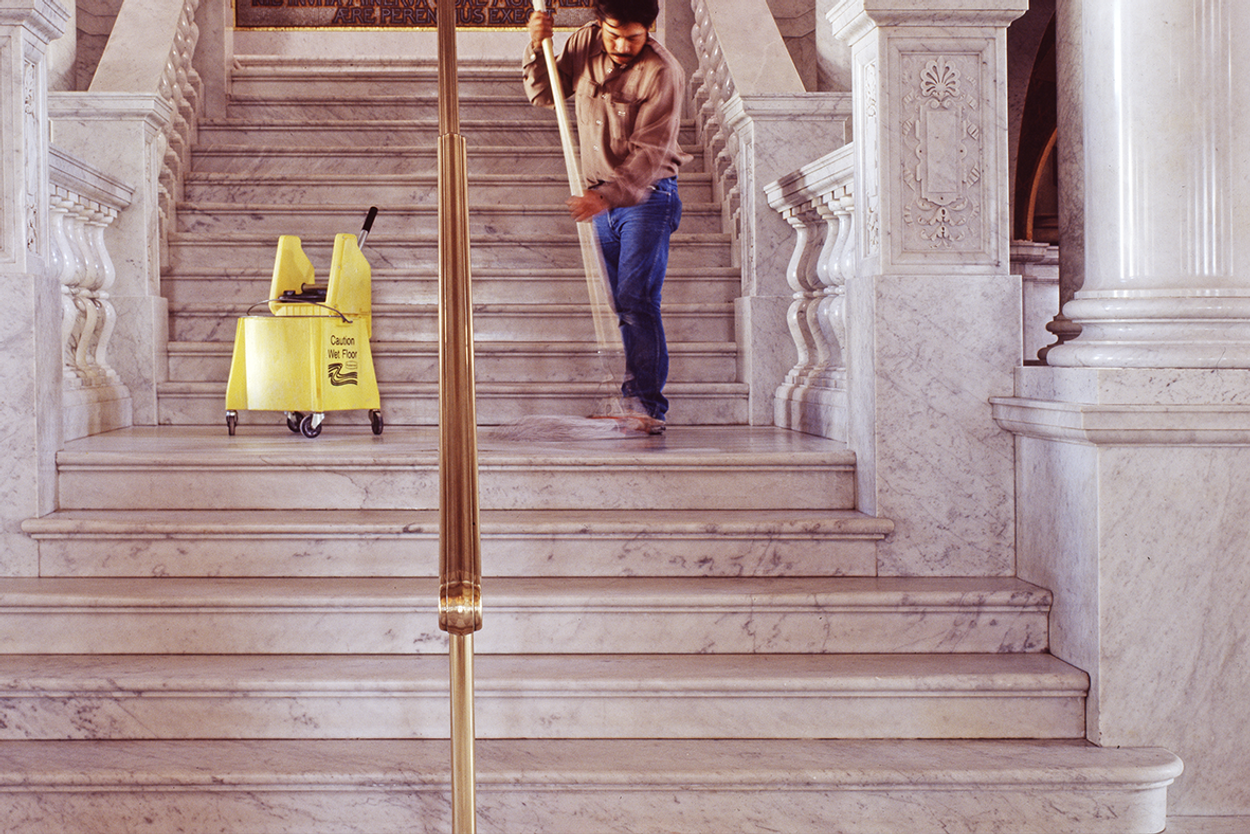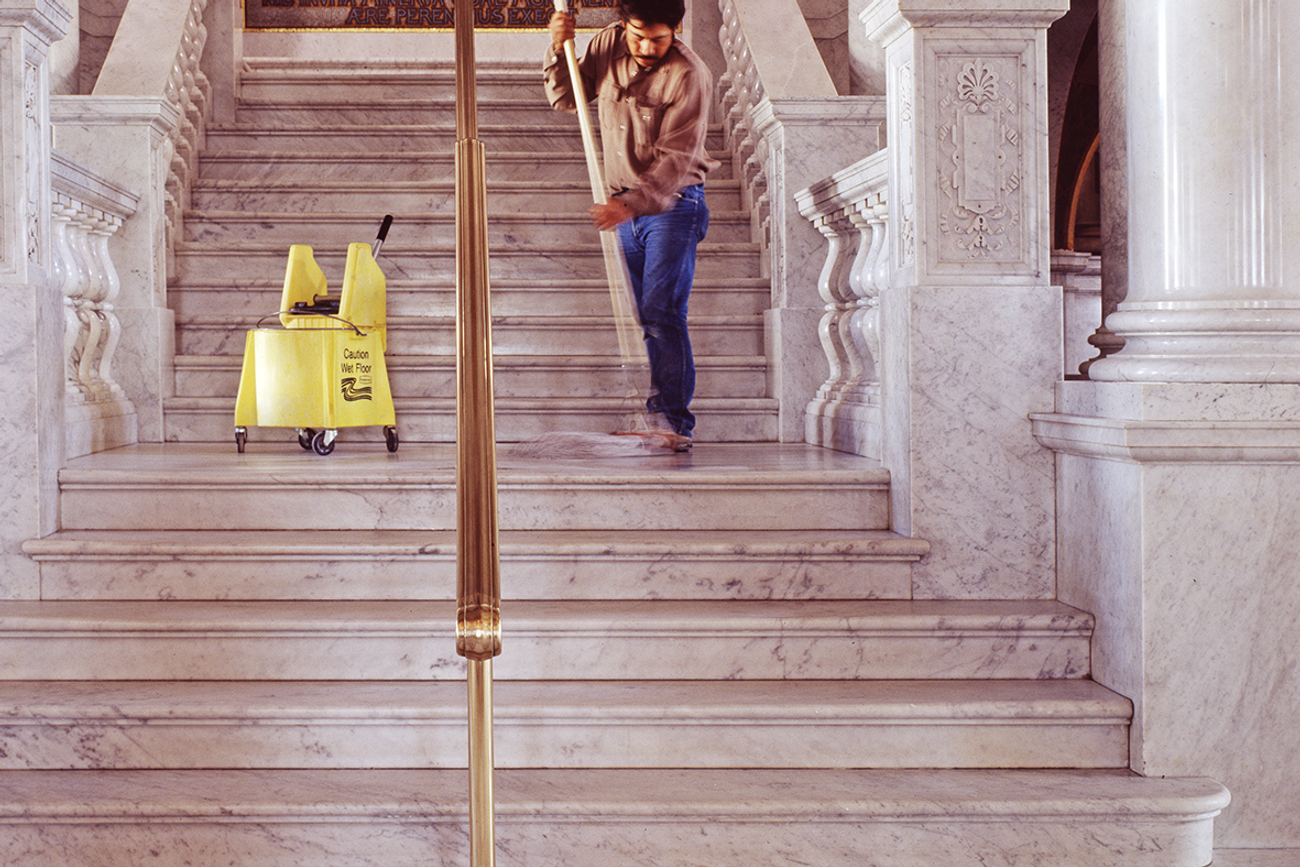Remember the Often Invisible Non-Jews Who Help the Jewish World Function
We tend to overlook the gentiles who keep synagogues running. As we begin the Torah anew, let’s acknowledge our debt to them.




A few weeks ago I went back to a shul I hadn’t visited since I was small. Who would still be there after 40 years, I wondered? Quite a few people, as it happened, but one man in particular stood out: someone who was a constant in the shul all those years before, someone I would see all the time as a boy, even though I didn’t really see him at all. At the time, I never even knew his name. He was the custodian, and he lived in the shul.
As a very short, quiet, unassuming Hispanic man, Mr. Roetta—that, I only now found out, is his name—might have gone entirely unnoticed except for his dog, a German shepherd he kept chained on the roof, where he barked furiously. I remember coming to the shul for the evening service and seeing the dog at the edge of the roof, howling at the sky.
It was odd to have a German shepherd at a shul where many of the members were survivors; the rabbi himself, a famous Polish refugee, came to London via Vienna on the eve of the war and survived the blitz before he came to this congregation in Queens. But no one in the shul ever said a thing about the dog—or about Mr. Roetta; it was as if they weren’t even there.
But even after 40 years, I recognized him immediately. He strode upright across the room with a strength that bespoke a man much younger and began setting up the kiddush. “He’s 92,” someone in shul told me. “The dog is long gone, but he is still cleaning up around here, mopping the floors in the bathroom and in the halls. In winter he is in front at first light with the snow blower.” Concealed in his small frame was a certain will, even an enthusiasm for manual labor, somewhat foreign to my Polish-Jewish bones.
A memory came back to me when I saw Mr. Roetta: Yom Kippur 40 years ago, almost to the day—Oct. 6, 1973. It was 3:00 in the afternoon, the sun was past its height, and the rabbi, in his holy garments, abruptly stopped the services. He klopped on the prayer stand: “There are reports of heavy fighting in the Sinai and the Golan; there are serious casualties.” How had he known? No one could have been listening to the radio or television on the holiest day of the year. It was a large shul and there was a silence I will never forget for all my life. One had to presume Mr. Roetta had informed the rabbi—and indirectly, the whole congregation–that “we” had been attacked. He had always been devoted to the rabbi and the shul. He still is.
It got me to thinking about the various people in the shuls that I have been, custodians and others, many of them not of the tribe, but somehow by virtue of their devotion to their jobs and to their synagogues, partially of the faith.
***
When I was a young man, I would spend summers at Camp Morris, the storied, summertime Catskills home of Yeshiva Rabbeinu Chaim Berlin. One year in late spring when I was in 10th grade, lightning struck the main building of the camp that housed the bais medrash and the dining room. The 100-year-old wooden structure burned to the ground in minutes.
A swift campaign was launched to rebuild in time for summer. Funds were raised, and miraculously, a new building was completed in less than two months. At the entrance to the new bais medrash was a plaque with the names of the major donors. Alongside the usual Jewish names you might expect was the name Patrick Henry. Campers stared in disbelief: Who was Patrick Henry?
We thought it must have been some kind of joke, but Patrick Henry was one of the janitors in the yeshiva. He was the closest living thing to the cartoon character of Popeye anyone will ever see in this lifetime. He smoked a corncob pipe, had maritime tattoos (anchors!) on his hand, and looked like he had been a deckhand on a whaling ship off Nantucket in the year 1840. He bumped his gums when he ate, because he’d lost most of his teeth. He must have been around 70 when he first came to the yeshiva. Yet there he was, bent but not weak, washing the bathroom floors and the hallways and ladling out the green peas and mashed potatoes on the chow line at lunchtime.
“Pat,” one of the rabbis told us (no one knew his last name), “emptied his life savings and gave it to us.”
We were shocked. Here, a man who we thought of as nothing more than a drunken sailor gave all his money to build a bais medrash—a place to study Talmud day and night, a place we assumed he could not begin to identify with. One of my cynical friends quipped: “A goy—a shikker—what do you expect? What else he is going to do with his money?” My rebbe gave him a sharp, shaming look and scolded: “You think he had nothing better to do than to give it to us? It was an act of tzidkus—righteousness. Here, a man of 75 cleans up the kitchen and the hallways without a krechtz to anyone and on top of it all, he gives his money. Only a fool could make light of him.”
***
Every synagogue, yeshiva, and Jewish institution has people like Mr. Roetta and Pat the janitor: non-Jews who toil in the Jewish world without ever becoming fully part of it. They are often invisible—we see them, but we don’t see them, as though we can never imagine them beyond their silent supporting roles. The fact is that they have always been part of our culture, the hewers of wood and the carriers of water going back to the days of the Temple. Even if they are not fully part of the Jewish world, neither are they fully separate. As we start a New Year and begin the Torah anew, we might take a new look at those who help us and the debt we owe them, the non-Jews without whom the Jewish world could not function.
Isaac Bashevis Singer once wrote about a Polish Catholic wash woman who laundered the clothes of the Jewish residents of Krochmalna Street. She was already past 70 when she started working for his mother. But this wash woman, “small and thin as she was, possessed a strength that came from generations of peasant forebears.” And could she wash clothes! “The white linens shone like polished silver,” Singer wrote in his famous short story collection In My Father’s Court. After many years when she was well past 80, the woman got sick and disappeared for a few weeks with the bundle of laundry they entrusted her with.
Rumors passed around that the wash woman, who lived in another district, died. They mourned her loss—and their linens, which included holy garments. All hope seemed lost, when one day in the dead of winter, there was a knock at the door: “a puff of steam, a bundle and a woman who resembled a corpse” entered the room.” On her last breath the woman had delivered the laundry. “The wash had not let me die,” she said. “I had to deliver it.”
Day after day, night after night, week after week, we return to the synagogue and the House of Study; so do “they” who have given of themselves to us even as they are separated from us by role, culture, and religion. Our sages refer to the shul as a mikdash me’at, a miniature temple. Couldn’t shul be a place where holy souls meet no matter their creed, their religion, or the roles they play in this life on earth? We should certainly hold this hope. I would not be part of a religious world without it.
***
You can help support Tablet’s unique brand of Jewish journalism. Click here to donate today.
Alter Yisrael Shimon Feuerman, a psychotherapist in New Jersey, is director of The New Center for Advanced Psychotherapy Studies. He is also author of the Yiddish novelYankel and Leah.
Alter Yisrael Shimon Feuerman, a psychotherapist in New Jersey, is director of The New Center for Advanced Psychotherapy Studies. He is also author of the Yiddish novel Yankel and Leah.